Solar eclipse of April 8, 2024
| Solar eclipse of April 8, 2024 | |
|---|---|
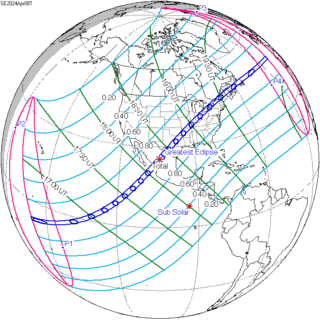 Map | |
| Type of eclipse | |
| Nature | Total |
| Gamma | 0.3431 |
| Magnitude | 1.0566 |
| Maximum eclipse | |
| Duration | 268 sec (4 m 28 s) |
| Location | Nazas, Durango, Mexico |
| Coordinates | 25°18′N 104°06′W / 25.3°N 104.1°W |
| Max. width of band | 198 km (123 mi) |
| Times (UTC) | |
| (P1) Partial begin | 15:42:07 |
| (U1) Total begin | 16:38:44 |
| Greatest eclipse | 18:18:29 |
| (U4) Total end | 19:55:29 |
| (P4) Partial end | 20:52:14 |
| References | |
| Saros | 139 (30 of 71) |
| Catalog # (SE5000) | 9561 |
A total solar eclipse will take place on April 8, 2024, visible across North America and Central America. A solar eclipse occurs when the Moon passes between Earth and the Sun, thereby totally or partly obscuring the image of the Sun for a viewer on Earth. A total solar eclipse occurs when the Moon's apparent diameter is larger than the Sun's, blocking all direct sunlight, turning day into darkness. Totality occurs in a narrow path across Earth's surface, with the partial solar eclipse visible over a surrounding region thousands of kilometres wide. With a magnitude of 1.0566, its longest duration of totality will be of four minutes and 28 seconds near the town of Nazas, Durango, Mexico, and the nearby city of Torreón, Coahuila.
Visibility

Totality will be visible in a narrow strip of land in North America, beginning at the Pacific coast, then crossing northern Mexico through the states of Sinaloa, Durango and Coahuila, in the United States, through the states of Texas, Arkansas, Missouri, Illinois, Kentucky, Indiana, Ohio, New York, and Vermont, and finally the southern parts of the provinces Ontario, Quebec and New Brunswick, western Prince Edward Island, and the island of Newfoundland in eastern Canada. Then, it will vanish at the eastern Atlantic Coast of Newfoundland. It will be the 2nd total eclipse visible from the central United States in just 7 years, coming after the August 21, 2017 eclipse.[1]
In Canada, the path of totality will pass over parts of southern Ontario (including Hamilton, Niagara Falls, Kingston, and Cornwall), parts of southern Québec (including Montréal and Sherbrooke), central New Brunswick (including Fredericton), western Prince Edward Island (including Tignish and Summerside) and central Newfoundland Island (including Gander and Grand Falls-Windsor). Note that some of these cities listed lie on an edge of the path of totality, such as Hamilton and Montréal. Toronto and Moncton, New Brunswick, lie just north and south of the path of totality, respectively.
Related eclipses
This eclipse will be the first total solar eclipse to be visible in Mexico since the solar eclipse of July 11, 1991.[2]
The path of this eclipse crosses the path of the prior total solar eclipse of August 21, 2017, with the intersection of the two paths being in southern Illinois in Makanda just south of Carbondale. A small land area, including the cities of Carbondale, Cape Girardeau, Missouri, and Paducah, Kentucky, will thus experience two total solar eclipses within a span of fewer than seven years.
Solar eclipses 2022-2025
Each member in a semester series of solar eclipses repeats approximately every 177 days and 4 hours (a semester) at alternating nodes of the Moon's orbit.
| Solar eclipse series sets from 2022-2025 | |||||
|---|---|---|---|---|---|
| Ascending node | Descending node | ||||
| 119 | April 30, 2022 Partial |
124 | October 25, 2022 Partial | ||
| 129 | April 20, 2023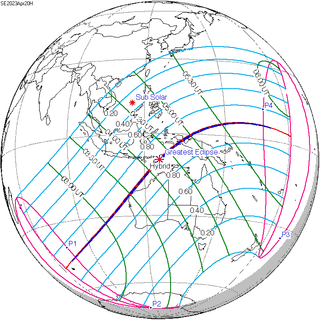 Hybrid |
134 | October 14, 2023 Annular | ||
| 139 | April 8, 2024 Total |
144 | October 2, 2024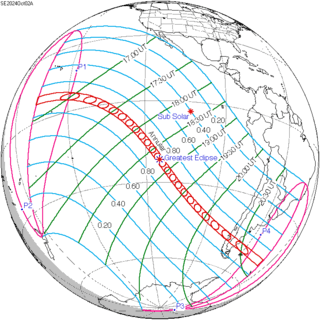 Annular | ||
| 149 | March 29, 2025 Partial |
154 | September 21, 2025 Partial | ||
Saros 139
It is a part of saros series 139, repeating every 18 years, 11 days, containing 71 events. The series started with partial solar eclipse on May 17, 1501. It contains hybrid eclipses on August 11, 1627 through December 9, 1825 and total eclipses from December 21, 1843 through March 26, 2601. The series ends at member 71 as a partial eclipse on July 3, 2763. Members in the same column are one exeligmos apart and thus occur in the same geographic area.
The solar eclipse of June 13, 2132 will be the longest total solar eclipse since July 11, 1991 at 6 minutes, 55 seconds.
The longest duration of totality will be produced by member 39 at 7 minutes, 29 seconds on July 16, 2186.[3] This is the longest solar eclipse computed between 4000BC and 6000AD.[4]
| Series members 24–39 occur between 1901 and 2100 | ||
|---|---|---|
| 24 | 25 | 26 |
 February 3, 1916 |
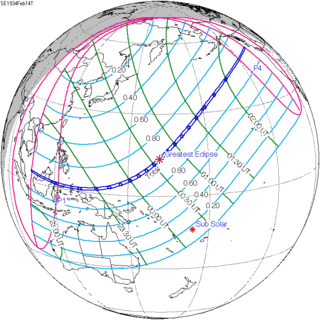 February 14, 1934 |
 February 25, 1952 |
| 27 | 28 | 29 |
 March 7, 1970 |
 March 18, 1988 |
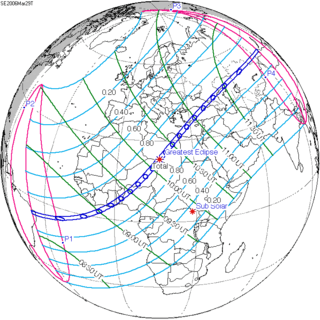 March 29, 2006 |
| 30 | 31 | 32 |
 April 8, 2024 |
 April 20, 2042 |
 April 30, 2060 |
| 33 | 34 | 35 |
 May 11, 2078 |
 May 22, 2096 |
 June 3, 2114 |
| 36 | 37 | 38 |
 June 13, 2132 |
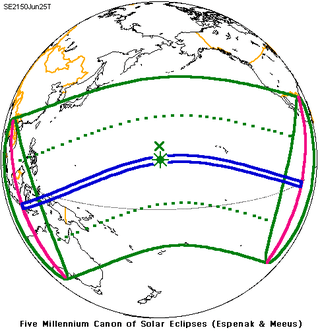 June 25, 2150 |
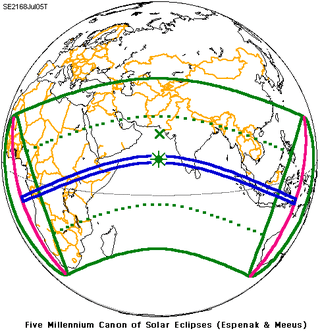 July 5, 2168 |
| 39 | ||
 July 16, 2186 | ||
Tritos series
This eclipse is a part of a tritos cycle, repeating at alternating nodes every 135 synodic months (≈ 3986.63 days, or 11 years minus 1 month). Their appearance and longitude are irregular due to a lack of synchronization with the anomalistic month (period of perigee), but groupings of 3 tritos cycles (≈ 33 years minus 3 months) come close (≈ 434.044 anomalistic months), so eclipses are similar in these groupings.
| Series members between 1901 and 2100 | |||
|---|---|---|---|
 March 17, 1904 (Saros 128) |
 February 14, 1915 (Saros 129) |
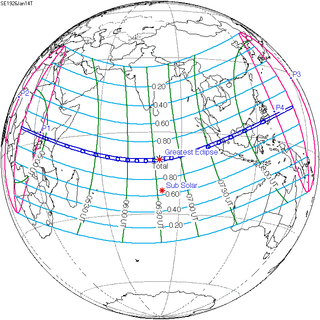 January 14, 1926 (Saros 130) | |
 December 13, 1936 (Saros 131) |
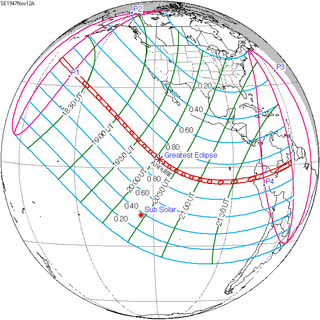 November 12, 1947 (Saros 132) |
 October 12, 1958 (Saros 133) | |
 September 11, 1969 (Saros 134) |
 August 10, 1980 (Saros 135) |
 July 11, 1991 (Saros 136) | |
 June 10, 2002 (Saros 137) |
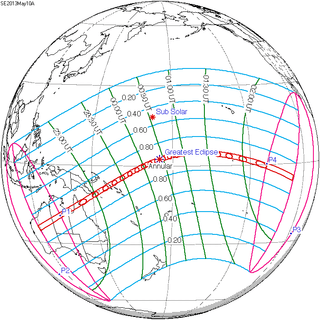 May 10, 2013 (Saros 138) |
 April 8, 2024 (Saros 139) | |
 March 9, 2035 (Saros 140) |
 February 5, 2046 (Saros 141) |
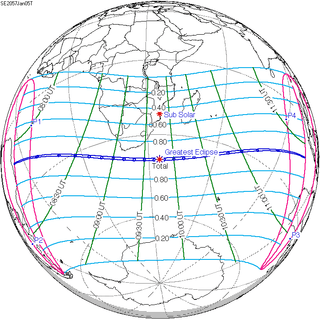 January 5, 2057 (Saros 142) | |
 December 6, 2067 (Saros 143) |
 November 4, 2078 (Saros 144) |
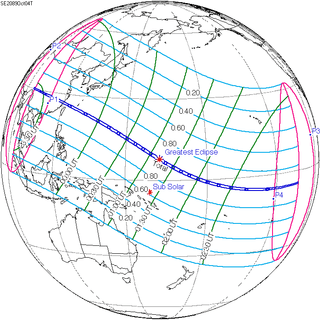 October 4, 2089 (Saros 145) | |
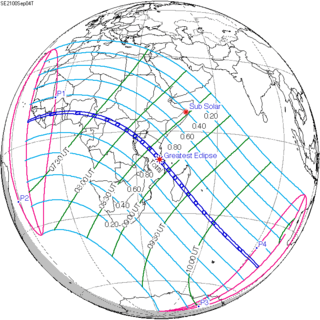 September 4, 2100 (Saros 146) |
|||
Metonic series
The metonic series repeats eclipses every 19 years (6939.69 days), lasting about 5 cycles. Eclipses occur in nearly the same calendar date. In addition the octon subseries repeats 1/5 of that or every 3.8 years (1387.94 days).
| 21 eclipse events between June 21, 1982, and June 21, 2058 | ||||
|---|---|---|---|---|
| June 21 | April 8-9 | January 26 | November 13-14 | September 1-2 |
| 117 | 119 | 121 | 123 | 125 |
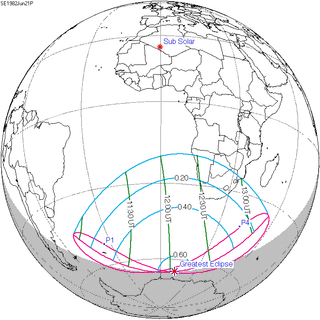 June 21, 1982 |
 April 9, 1986 |
 January 26, 1990 |
 November 13, 1993 |
 September 2, 1997 |
| 127 | 129 | 131 | 133 | 135 |
 June 21, 2001 |
 April 8, 2005 |
 January 26, 2009 |
 November 13, 2012 |
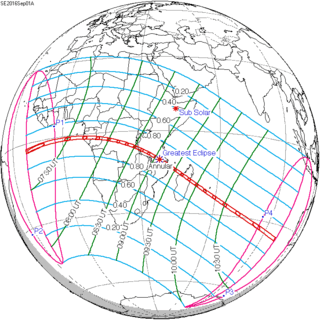 September 1, 2016 |
| 137 | 139 | 141 | 143 | 145 |
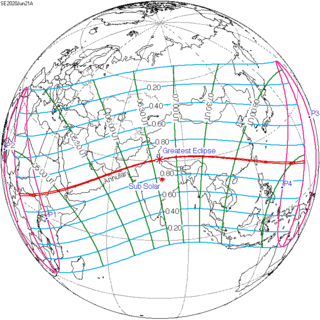 June 21, 2020 |
 April 8, 2024 |
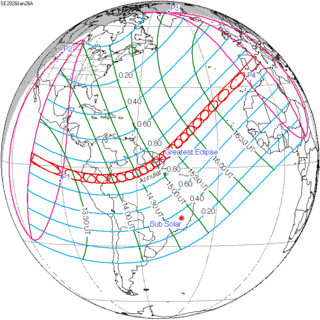 January 26, 2028 |
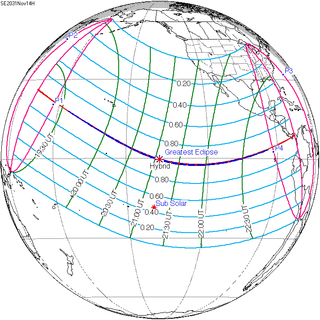 November 14, 2031 |
 September 2, 2035 |
| 147 | 149 | 151 | 153 | 155 |
 June 21, 2039 |
 April 9, 2043 |
 January 26, 2047 |
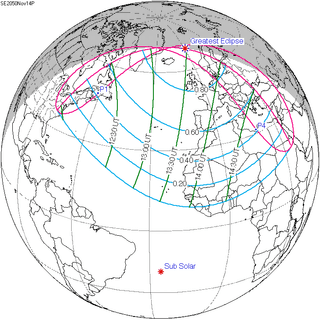 November 14, 2050 |
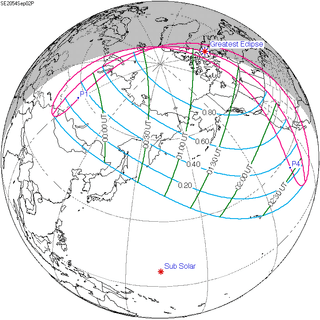 September 2, 2054 |
| 157 | ||||
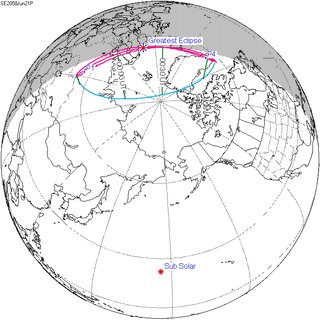 June 21, 2058 | ||||
References
- ↑ http://xjubier.free.fr/en/site_pages/solar_eclipses/TSE_2024_GoogleMapFull.html
- ↑ Total Solar Eclipse in Mexico, 1991 (in Spanish). National Autonomous University of Mexico. Retrieved 2009-04-02.
- ↑ Saros Series Catalog of Solar Eclipses NASA Eclipse Web Site
- ↑ Ten Millennium Catalog of Long Solar Eclipses, -3999 to +6000 (4000 BCE to 6000 CE) Fred Espinak
External links
- Hermit Eclipse: Total Solar Eclipse April 8, 2024
- Besselian Elements for the Total Solar Eclipse of 2024 Apr 08
